Fujifilm X-T3 Review
Fujifilm X-T3 Usability - How easy is it to use?
For the new X-T3, Fujifilm refined the hybrid analog and digital design introduced with the X-T1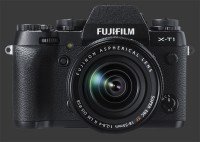
Fujifilm X-T1. It is a highly tactile design that combines traditional mechanical controls with the modern convenience of dual control-dials and an 8-way joystick. Although quite similar to its predecessor, Fujifilm is keen on making continuous improvements to the ergonomics their digital cameras.
The Fuji X-T3 is build upon a solid metal frame with rubber coating front and grip-side back of the camera. The entire camera feels very solid and dense.Weak points come do to hidges. There are two for the rear LCD. While the one enabling vertical tilt is among the most solid, the one for horizontal motion does not feel as durable. There is bit of flex to the plastic of the battery-compartment door which is made of plastic.
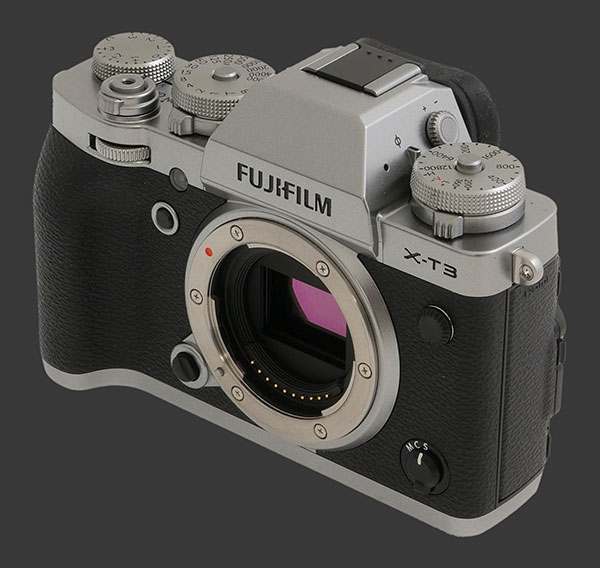
This is a mid-size mirrorless camera which makes it a little smaller than a DSLR, more so in depth. The rubber-coated grip at the front is shallow and narrow yet allows reasonable purchase over the camera when paired with a small to medium lens. A rubberized protrusion along the upper-rear edge of the body greatly helps keep the camera steady. Holding the camera, most controls on the grip-side are within comfortable reach. There are controls on the right too but since aperture is usually controlled by a ring around the lens barrel, one has to switch the hand position when changing ISO, Drive Mode.or Deleting files.
The front of the X-T3 has a few items around the lens mount. Starting clockwise from the upper-right, there is a standard Sync-Port to connect studio lighting. A 3-way Focus-Mode switch is found at the lower-right. This one selects between Manual, Continuous and Single focus. The Lens-Release is at the lower right of the lens mount. Higher up there is an unmarked customizable button, an AF-assist lamp and the front control-dial above it. The mostly redundant clickable front control-dial now protrudes slightly from the body, making it easier to use than previously. The dial has nice ribs and firm detents.
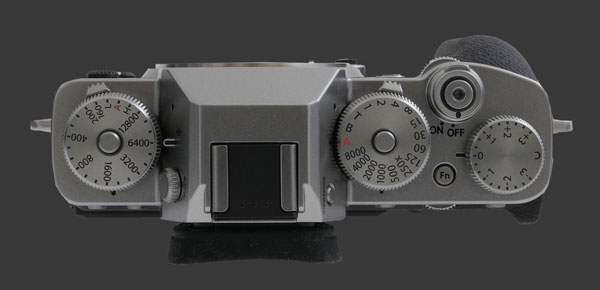
With three dials, two of them stacked, on the top plate, plus the aperture-ring on most Fujinon X-mount lenses, this is where the action is. All these controls make the top of the X-T3 rather crowded while making it possible to read the camera state without a status display. Although these dials make camera controls very accessible, they are unusually complicated. Top-plate controls from left to right:
The top half of the left-most dial controls ISO sensitivity. This ISO Dial has markings for ISO 200 to 12800 in full-stops with 1/3 steps in between. Within this range, control is direct and ISO can instantly be read. Unfortunately, there is insufficient space for all sensitivies in 1/3 stops, so Fujfilm added ISO 160, L, A and H positions:
- Unsurprisingly, ISO 160 sets the camera to ISO 160 which is the native sensitivity of the X-T3 sensor. All other positions are customizable.
- L accesses one expanded ISO, either 80, 100 or 125.
- H does the same for either ISO 25600 or 51200.
- A accesses either Auto ISO or delegates control over ISO to the front control-dial. Therefore, if the ISO dial is at the A position, senstivity can be set to anything, including one of 3 types of Auto ISO. Each of these can be customized futher in the Shooting Setting menu.
The ISO dial has moderately firm detents which diminishes the chances of accidental changes. A lock button in its center locks the dial at its current position. Since some positions are programable this therefore does not completely lock in ISO. Also note that, if one of the expanded ISO position is selected, the X-T3 will use the next closest standard sensitivity when the Electronic Shutter is engaged.
Right below the ISO dial, there is a Drive Mode dial which has 8 positions: Movie, Bracket, Continuous High, Continuous Low, Single-Shot, Multiple Exposure, Advaned Filter and Motion Panorama. The really good news is that the X-T3 has a Movie Mode which makes it ready to record video and switches the preview to the right aspect-ratio, either 16:9 or 17:9, depending on the format selected in the Video menu. Braket performs one of 6 types of braketing, as configured with the Shooting Setting menu. Most bracketing modes are highly customizable.
Continuous Drive modes are rather complex on the X-T3. There are 6 speeds to choose from for Continuous High and 4 for Continuous Low which tops out at 5.7 FPS, the maximum speed at which continuous AF and AE are possible. All Continuous Drive modes are covered in the previous page of this digital camera review. Multiple-Exposure creates a photo by super-imposing two images and support retrying for the second frame. Advanved Filter mode offers a choice of simple filters which can all be done by software instead. Motion Panorama captures a wide or extremely wide field of view by panning the camera in any direction. The only issue with the Drive Mode dial is that it is easy to rotate the ISO dial while changing drive modes, unless the ISO dial is locked, of course.
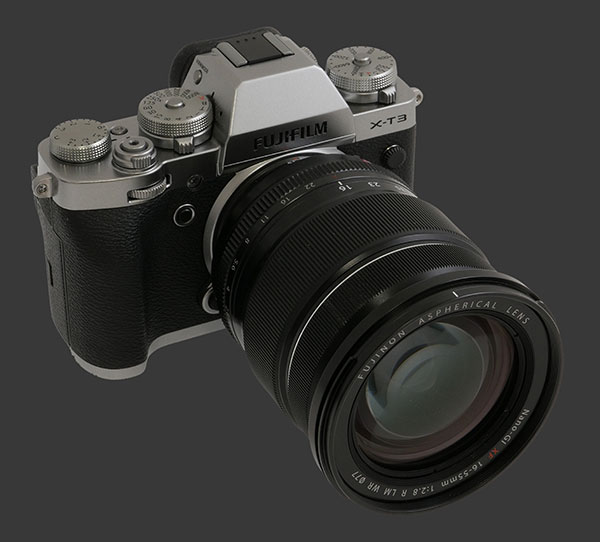
Between the ISO dial and the Shutter-Speed dial, there is the housing for the built-in EVF. On top of it, there is a standard hot-shoe to connect an external flash. On the side of the housing, a View Mode button cycles over different modes for the Eye-Start Sensor. The most practical one turns off both the EVF and LCD until the sensor is triggered. This can save battery-life, as long as Eye-Start Sensor is not triggered by something else. Other modes select the EVF, LCD or automatically switch between the two.
The Shutter-Speed dial is the most anachronistic control on this mirrorless digital camera. It is marked in full-stops with no intermediate detents from 1s to 1/8000s. The rear control-dial must be used to select 1/3 stops or any shutter-speed outside of this range. The T position allows any shutter-speed compatible with the selected shutter type to be dialed-in using the rear control-dial. The B position enables Bulb mode, as long as the Electronic-Shutter is not selected, otherwise it always exposes for one second only.
Like the ISO dial, the Shutter-Speed dial has an A position to make shutter-speed selection automatic. This effectively puts the camera into P or A mode, depending if the lens aperture is on Auto or not. On prime lenses, this is a distinct position of the aperture-ring. On zooms, there is an Auto switch on the lens barrel. The Exposure-Mode is implicit by the placement of these dials. This interface is crucial to understand. Any accidental movement of these dials causes the mode to change which is why Fujifilm placed a lock button on the Shutter-Speed dial too.
There are actually two more dials on the top plate. The Metering Mode dial is just below the Shutter-Speed dial. It selects between all metering modes: Multi-Segment, Center-Weighed, Spot and Average. The final dial is for Exposure Compensation. It is marked in ±3 in 1/3 EV steps. There is also a C position that allows the front control-dial to set ±5 EV of EC. When mutiple parameters get mapped to the front-dial, such as having both EC and ISO set to A, the front control-dial must be clicked to cycle over available parameters.
Some photographers complain that the locks slow them down, while others find them essential. There is no lock on the EC dial which is another one that can accidentally lead to incorrect exposuret. Of all these controls, the aperture-rings on lenses are the most problematic. This forces photographers to constantly keep an eye on the aperture shown on the EVF or LCD.
Tucked between the Shutter-Speed and EC dials, and we really mean tucked, there is a small and hard-to-reach customizable Fn button. Luckily, the X-T3 has a total of 6 user-defined buttons. In front of the Fn button, lined-up with the inner-edge of the grip, there is a standard two-stage shutter-release with moderate travel to the halfway point. The shutter-release is surrounded by a rotating power-switch.
Both sides of this digital camera have a hard plastic door. On the left, there are HDMI and USB-C connectors plus two mini-jack. One mini-jack serves as stereo audio input or wired remote, the other to connect a stereo headset. The right door covers dual SDXC memory card slots, both supporting UHS-II cards. This door has a soft rubber seal to protect the compartment from adverse weather.
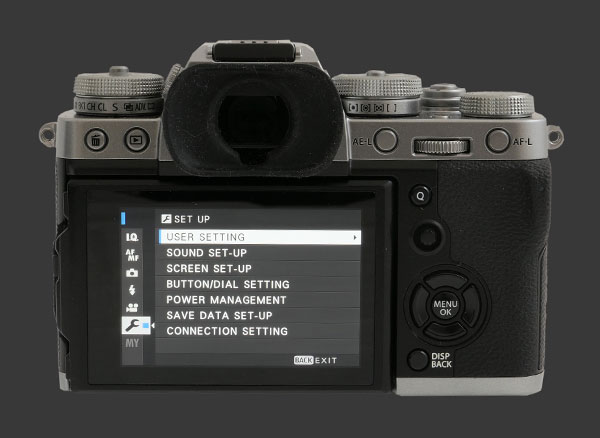
The Fujifilm X-T3 features a high number of controls on its back which is dominated by a wide 3" tilting 1 megapixel LCD. Right above the screen, there is a 0.5" EVF with a large 0.75X magnification and an outstanding 3.7 megapixels of resolution. This EVF is a marvel to look at. It is extremely sharp and refreshes at 100Hz which renders motion very fluid. Contrast is excellent and colors look remarkably natural. New to the X-T3 is its Sport Finder mode which shows a 1.25X crop frame within the full image. At 20 or 30 FPS, this mirrorless captures exactly what is shown in that region while allowing the photographer to see just outside of it. This facilitates framing of fast moving subjects.
In low-light, the EVF maintains a relatively bright image while getting noisy. A lag is perceptible in moderately dark locations which is to be expected. Noise in the preview fluctuates which makes confirming focus a little difficult in low-light. Luckily, the X-T3 has a number of Manual Focus Assist modes, including the unique Digital Split Image, Digital Microprism plus the usual Electronic Magnification and Focus Peaking. The latter two are available at all times, while the former can only be used with the camera in MF mode.
Where both displays falter is that they are only Exposure-Priority in Manual exposure. The most significant advantage of an EVF over OVFs found on DSLR is that they read data right off the sensor are capable of showing a representative preview, yet it is not the case most of the time with the X-T3. The histogram is based on the display so its only accurate in Manual exposure mode.
The back of the camera is plastered with buttons. Directly to the left of the EVF, there are Delete and Playback buttons which work as usual. It is not possible to delete an image from the Instant Review though. On the other side of the EVF, one finds the rear control-dial which is clickable, with AE-L to one side and AF-L to the other. Both these buttons are customizable. Even the click action of the rear control-dial can be changed with 42 functions to choose from. The default is to activate Focus Check.
Below the rear control-dial, the Q button brings up the classic Fujifim 4x4 grid of icons. When this menu is open, an 8-way joystick just below the Q button selects an icon and the rear control-dial cycles over available settings. It is puzzling why the front dial does not serve this function since it would make changing settings much more ergonomic, rather than constantly moving the thumb between the joystick and dial. The 8-way joystick is highly versatile. In Capture mode, it selects the Focus Point or Focus Area. It can also navigate the menu system. Pressing the joystick serves as OK button or to center focus.
There is a 4-way controller with a central OK button further down. The middle button opens the Menu system while each directional one can be assigned an individual function. Each direction can be assigned oneof 42 functions. Among those, there are a wealth of useful functions. The last button on the back is the Disp/Back button which is used to cycle over display modes or cancel actions in progress.
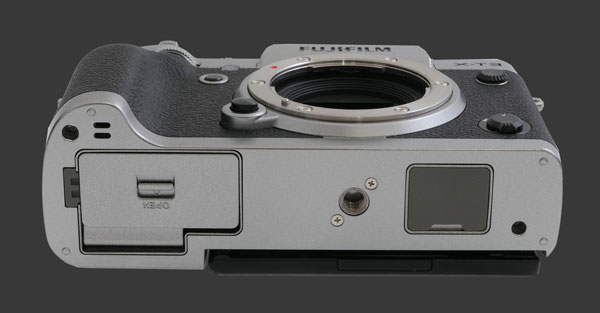
The bottom of the X-T3 has a metal tripod mount which is in-line with the optical axis of the camera. This is ideal for panorama photography. There is also a plastic battery-compartment door and a battery-grip connector covered by a rubber rectangle which detaches completely from the camera.
Fujifilm has made a number of improvements to the ergonomics of their X-T series cameras since the introduction of the original X-T1. Buttons and dials are all in the right place while giving access to all major functions, yet controlling the camera remains overly complicated. ISO and Shutter-Speed dials are incomplete and need to be complemented by menu options and a control-dial to cover their entire range. Both can be fully replaced with dual control-dials by setting ISO to A which must be configured for direct control and Shutter-Speed to T. This leaves the EC dial to do what it is there for. That can be replaced too though but then the front control-dial must be clicked to cycle over different parameters which makes the camera interface modal.
Both lower halves of the stacked dials are challenging to access and may cause their upper counterpart to rotate accidentally which is why these dials have locks. It seems like firmer detents would have solved the problem more efficiently. The EC dial is a little too easy to knock out of place and, although not specific to this camera, all Fujifilm X-mount lenses have way too soft aperture detents. This means that the X-T3 is more prone to shooting at the wrong setting than a camera of this caliber should.
Although there is complexity and a number of minor ergonomic issues, the Fujifilm X-T3 is one of the most efficient camera to control. Setup a certain way, one quickly learns to work around the pitfalls and make this mirrorless and reliable digital camera.
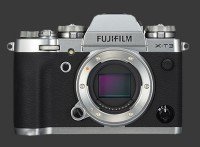 |
Please Support Neocamera
All information on Neocamera is provided free of charge yet running this website is a huge endeavor. Purchases made via affiliate links found throughout the site help keep it running and up-to-date. There is no additional cost to you, so please consider buying via these links to our affilates:
If you found any information on this site valuable and did not purchase via our affiliate links, please considering donating via PayPal:
Any amount will be greatly appreaciated. Thank you for your support!
Fujifilm X-T3 Highlights

Sensor-Size: 24 x 16mm

Actual size when viewed at 100 DPI
| 26 Megapixels Mirrorless | ISO 80-51200 |
| Fujifilm X Mount 1.5X FLM | Shutter 1/32000-900s |
| 0.50" Built-in EVF 3.7 Megapixels (0.75X) | Full manual controls, including Manual Focus |
| Automatic Eye-Start sensor | Custom white-balance with 2 axis fine-tuning |
| 1 Axis Digital Level | Spot-Metering |
| Weatherproof down to -10C | Hot-Shoe & Sync-Port |
| Built-in Dust Reduction | Stereo audio input |
| 20 FPS Drive, 79 Images | Lithium-Ion Battery |
| 4096x2160 @ 60 FPS Video Recording | Secure Digital Extended Capacity x 2 |
| 3" LCD 1 Megapixels |
Updates
2024.04.03

Fujifilm X-T5 Review
Newest Fujifilm flagship boasting a 40 MP APS-C sensor, 5-axis IBIS with 7-stop efficiency, 15 FPS continuous drive, 6.2K Video capture, dual control-dials and dual SDXC UHS-II slots in a sturdy weatherproof and freezeproof body.
2023.11.20

Best Digital Cameras of 2023
Find out which are the Best Digital Cameras of 2023. All the new Mirrorless Digital Cameras from entry-level to high-end professional.
2023.07.10

Fujifilm X-H2 Review
40 Megapixels APS-C Hybrid Mirrorless Digital Camera with 7-stop IBIS. Fastest shutter ever and 8K video capture. Large builtin EVF with 0.8X magnification and 5.8 MP, plus an Eye-Start Sensor. Packed with features and large number of controls in a weatherproof and freezeproof body.
2023.05.07

Sony FE 20-70mm F/4G Review
Review of the unique Sony FE 20-70mm F/4G lens. The optical zoom of this lens spans ultra-wide-angle and medium focal-length coverage, making it one of the most versatile Full-Frame lenses on the market.
2023.01.15

Huion Inspiroy Dial 2 Review
Review of the Huion Inspiroy Dial 2 tablet, a medium sized drawing surface with dual dials and customizable buttons. Connects via USB-C or Bluetooth 5.0 with Windows, Linux and Android support.
2022.12.08

How to Pack for a Photo Trip
Find out how to pack for a travel photography trip, carry your gear safely while meeting airline regulations.
2022.11.13

Best Digital Cameras of 2022
The best digital cameras of 2022. A short list of the most outstanding models in their respective categories. Choose one for yourself or as a gift.
2022.09.21

Pentax DA* 60-250mm F/4 SDM Review
Review of the Pentax DA* 60-250mm F/4 SDM, the constant-aperture telephoto zoom with the highest zoom-ratio on the market.
2022.09.20

Pentax DA* 50-135mm F/2.8 SDM Review
Review of the Pentax DA* 50-135mm F/2.8 SDM, the lightest professional telephoto zoom native to the K-mount.
2022.09.10

Pentax DA* 11-18mm F/2.8 DC AW Review
Review of the Pentax DA* 11-18mm F/2.8 DC AW, the widest professional ultra-wide zoom native to the K-mount.
2021.11.24

50 Gifts Under $50 For Photographers in 2021
50 Gifts photographers will love. All for under $50 USD. 2021 Edition.
2021.11.17

Best Digital Cameras for 2021
Neocamera shows which are the very best Digital Cameras for 2021 in every category: Mirrorless, DSLR, Premium Compact, Ultra-Zoom and Rugged.












